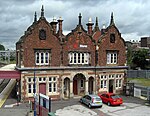Stafford services
1966 establishments in EnglandBuildings and structures in StaffordshireM6 motorway service stationsMoto motorway service stationsRoadChef motorway service stations ... and 2 more
Transport in StaffordshireUse British English from March 2017

Stafford services is a pair of motorway service stations on the M6 motorway near Stone, Staffordshire, England. In August 2011 it was rated as 4 stars (northbound - Moto) and 3 stars (southbound - Roadchef) by quality assessors at Visit England.It is unusual, in that the facilities on the northbound (opened 1996) and southbound (1999) sides of the motorway are operated by separate companies: Moto (formerly Granada) and Roadchef respectively. They are 1 mile (1.6 km) apart.
Excerpt from the Wikipedia article Stafford services (License: CC BY-SA 3.0, Authors, Images).Stafford services
Costa Drive-Through,
Geographical coordinates (GPS) Address Nearby Places Show on map
Geographical coordinates (GPS)
| Latitude | Longitude |
|---|---|
| N 52.88436 ° | E -2.17083 ° |
Address
Moto Stafford North Services
Costa Drive-Through
ST15 0EU
England, United Kingdom
Open on Google Maps






